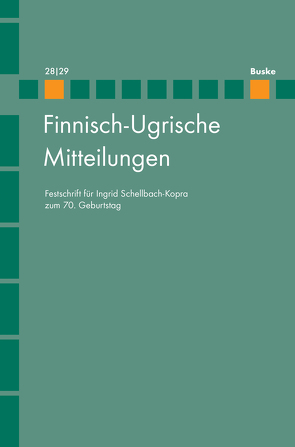
Abstracts
Originalia:
Elizaveta Kotorova (Zielona Góra / Tomsk) – Andrey Nefedov (Hamburg): Besonderheiten des Kommunikationsverhaltens der indigenen sibirischen Völker (am Beispiel des Ketischen)
The peculiarities of communicative behavior within the national culture are determined, on the one hand, by certain linguistic means, and on the other hand, by the rules defining how to use these means. In this article, we identify the following main features of speech behavior patterns implemented by speakers of indigenous languages of Siberia, in particular by the Ket language speakers: 1) Etiquettical speech behavior patterns are implemented in most cases not verbally, but actionally; 2) There are practically no native politeness formulas, instead of them arbitrarily formulated statements or borrowed etiquette clichés are used; 3) Informative speech behavior patterns can be implemented both verbally and actionally; 4) Such communicative and pragmatic factors as age, social status and social distance do not seem to affect the implementation of directive speech behavior patterns.
Miika Lehtinen (Oulu): Skolt Saami passive verbs
This paper deals with the Skolt Saami passive verb suffixes -j- and -õõvvâ- (e.g. mott-j-ed ‘change (intr.)’, rottš-õõvvâ-d ‘be pulled’) cognate with North Saami -o(j)- and -uvva- (e.g. dahkk-o-t ‘be done’, muhttaš-uvva-t ‘change (intr.)’) as well as Finnish -u- ~ -y- (e.g. käänt-y-ä ‘turn (intr)’). The research material has two complementary parts: a dialectal dictionary and a speech corpus. The semantics of the relevant verbs in the material is examined. The main distinction is made between intentional passives (true passives having a volitional agent) and automative passives (actions that happen spontaneously or by accident, anticausatives). The results show that at least the suffix -jed and to a lesser extent -õõvvâd are mainly used to mark automative passives, but some instances of intentional passives are also found as well as some cases that are ambiguous between the two. The suffix -õõvvâd is used in the passive function more rarely than the suffix -jed and it has more functions.
Sándor Maticsák (Debrecen): Die mordwinische Sammlung aus der Orenburg-Expedition von Pallas (1768–1774)
The 1769 transit of the Venus across the Sun was always an important astronomical event, because it made possible for astronomers to calculate the distance between the Sun and the Earth. 151 scientists and scholars travelled to 77 pre-selected spots around the world to observe the transit.
In 1768, the Imperial Academy of St. Petersburg organized five expeditions besides the Venus-observing teams to explore the flora, the fauna, the geological and the meteorological characteristics of far-off territories in Russia. The travellers obtained a large amount of information about the residents, customs, lifestyle and culture of these far-off lands, including some linguistic material as well. They wrote travelogues about their experiences.
The leader of the expedition was Peter Simon Pallas (1741–1811), the renowned Swedish natural scientist, and the subdivisions were led by German, Swedish and Russian scientists and scholars. Between 1768 and 1774, Pallas travelled around the Middle Volga Region, the Orenburg Region, Bashkortostan, Southwest Siberia and finally he reached as far as Buryatia. His travelogue was published in three volumes between 1771 and 1776 titled Reise durch verschiedene Provinzen des Russischen Reichs.
Pallas’s book contains linguistic material from several languages, Mordvin, Khanty, Mansi, Samoyedic, Mari and Udmurt included. Most of the words are animal and plant names and vocabulary related to clothing and religious beliefs. The Mordvin material is made up of 83 words. The first volume of the travelogue contains 34 of these, which are mostly names for pieces of clothing and medicinal herbs. The third volume contains a multi-lingual glossary, 49 Mordvin words (mostly from the basic vocabulary) included.
The present paper analyses these Mordvin words. Earlier literature studied only a few of them. The majority of the words occur for the first time ever in Pallas’s work.
Natalia Pimenova (Moskau): Prähistorische Kontakte der Eskimo-Aleutischen und austronesischen Sprachen: sprachliche Zeugnisse im „altaischen“ und „uralo-sibirischen“ Kontext
The Eskimo-Aleut languages are believed to represent a separate prehistoric migration of people from Asia. The more credible proposals on the external relations and prehistoric contacts of Eskimo-Aleut concern one or more of the language families of northern Eurasia. The two serious genetic hypotheses are ‘Altaic’ and ‘Uralo-Siberian’ or more inclusively ‘Nostratic’ (‘Eurasiatic’). With using a comparative analysis method, this paper provides data for connections between Eskimo-Aleut and Austronesian languages. The comparative word-list consists of comparisons of Proto-Eskimo (PE) or Proto-Eskimo-Aleut (PEA) and Proto-Austronesian (PAN) and Proto-Malayo-Polinesian (PMP) words put together by the author.
The material includes lexical entries that the author believes to be strong evidence for the Austronesian influence on Eskimo and Aleut languages. We can explain the lexical similarities as a result of a prehistoric substratum or convergence of proto-languages (contacts with peripheral prehistoric Austronesian subgroups).
Austronesian and alternate Uralo-Sibirian or Altaic etymologies of Eskimo words are discussed.
Sándor Szeverényi (Szeged): Tense in Nganasan narratives
The main objective of the study is to categorize the use of verb tenses in Nganasan personal narratives. The study is corpus-based, with texts found in the annotated Nganasan Spoken Language Corpus (Brykina et al. 2018). The motivation of the study is to describe the various and complicated system of TAME categories in Nganasan. The analysis proves that a relation of the use of past tense and perfective aorist and their role in the storytelling may be motivated by ethnosyntactic factors. An ethnosyntactic base can be detected behind the use of the aorist – but full-fledged proof of this requires further investigation, into notions such as the “value” of time in the Nganasan culture. It seems that in the use of the aorist the prominence of the present moment and real-time of life is reflected. Labov’s oral narrative structure description is applied to the Nganasan narratives as well. The research focuses on the relation of the beginning and the main parts, i.e. the Abstract/Orientation and Complicating Action. In Nganasan stories, we find sequences: typical beginnings and segments. These are well reflected in the tense of the foreground. A relevant part of the foreground can be the utterances of the characters that belong to the mainline. The two main strategies are the use of past tense and perfective aorist. It means that there are two basic story-telling temporal frames: perfective aorist and general past tense. The first one is more typical in the folklore genres. These two strategies can be combined with narrative/reportative evidentiality. Several aspects play a role in the “choice” of tense, one of the most important being the role of the speaker and their relationship to the story. This is well reflected, for example, between the introductory parts (Abstract and Orientation) and the dominant tense of the main story-line (Complicating action).
Sándor Szeverényi and Beáta Wagner-Nagy: Verbs of speaking in Nganasan: A corpus-based approach
The study aims at categorizing verbs of speaking and thinking in Nganasan. All verbs that can be associated with thinking and speaking are examined in the texts found in the annotated Nganasan Spoken Language Corpus (Brykina et al. 2018). The approach as a whole is rather formal and quantitative, primarily focusing on which verbs are involved in constructing report speech. It can be shown that in the Nganasan texts, several verbs express utterances, but according to their number of occurrences, munu- ‘say’ is the most common and most frequently used verb of speaking. According to the distribution in the corpus data, it seems that the overall number of verb-of-speaking is not high.
Aktualisiert: 2023-06-16
> findR *

Abstracts
Originalia:
Josefina Budzisch – Ulrike Kahrs (Hamburg): Cardinal directions in Selkup
The paper deals with the denotations of the main cardinal points in Selkup, taking all three main dialect groups (Northern, Central and Southern) into account. The naming of cardinal points is not well studied for Selkup, there is a lack of analysis of the underlying semantic structure of the denominations – this study aims at closing that research gap and giving some insights in environmental and cultural factors playing a role in expressing cardinal points. The paper has the following structure: after a brief introduction, the current state of research is presented as well as the data used in the study, the main section deals with the analysis of the underlying structures in denoting south/north and east/west. The findings are summarized in the final section.
Sándor Szeverényi – Katalin Sipőcz (Szeged): Formen der direkten und indirekten Redewiedergabe im Nganasanischen und im Mansischen
In this paper we examine reported speech constructions in two Uralic languages spoken in Siberia, Nganasan and Mansi. We also examine whether areal - primarily Russian - influence can be found in these structures. Indirect speech report with person shift are rare in the languages studied, but sporadic data can be found in the corpus for this type, too. In Mansi and Nganasan the direct reported speech structure is much more common than indirect. It can be observed that in languages the direct speech structure consisting of two clauses requires a complementizer resulting subordinating clauses. Such complementizers do not exis in these languages, although there are examples in our corpus for the adaption of the Russian conjunction što ‘that’. In Mansi, in addition to the direct structure we can find indirect type without conjunction, and non-finit structure can be used, too. In Nganasan the reportative evidential serves as an alternative strategy.
Denys Teptiuk (Tartu): Quotative indexes in Erzya: a typological overview
In this paper, I provide a typological overview of quotative indexes, i.e. linguistic expression(s) encoding the presence of reported speech and thought, in contemporary Erzya. I focus on quotative strategies of different complexity attested in social media texts and classify the constructions according to their morphosyntactic structure and orientation. Furthermore, I take into account the possible connotations arising in the use of concrete strategies, such as the precision of reported discourse vis-à-vis original discourse, the reporter’s evaluative connotations concerning reported information and ambiguity in the presentation of speech and thought. The results of this study show that the markers used in Erzya quotative indexes correspond to their uses in other related languages and reflect cross-linguistic tendencies in the use of semantically reportative and non-reportative markers in quotative constructions.
Enikő Tóth – Péter Csatár (Debrecen): A comparison of Hungarian focus structures: experimental insights
Our paper reports the results of an experiment we conducted to compare Hungarian preverbal focus (PVF) and syntactically unmarked focus (SUF) within the same experimental framework. The aim of the experiment was twofold: (i) to examine whether native speakers give higher ratings for PVF/SUF constructions in exhaustive settings than in non-exhaustive ones, (ii) to test whether the mode of presentation (written vs. auditory clues, no introductory question vs. the presence of an introductory wh-question) influences the ratings. We used a sentence-picture verification task in a relatively rich context. We found no empirical difference between PFV and SUF across the conditions, i.e. SUF might also receive an exhaustive interpretation (Surányi 2011). The results regarding the role of the wh-question are in line with Onea and Beaver’s work (2011) on PVF. Our findings support the assumption that for both structures exhaustiveness can be explained by the presence of a not necessarily explicit introductory wh-question, namely, a contextually derivable implicit question under discussion also facilitates the exhaustive interpretation.
Diskussion und Kritik:
Volker Pirsich (Hrsg.): Die Nadelwälder dunkeln fort im Osten. Deutschsprachige Gedichte über Finnland und die Finnen. Grevenbroich: Heiner Labonde Verlag 2019. 167 S. (Veröffentlichungen der Aue-Stiftung, 42).
Jukka Korpela: Slaves from the North. Finns and Karelians in the East European Slave Trade, 900 – 1600. Leiden, Boston: Brill 2019. 306 S. (Studies in Global Slavery, Volume 5).
Musäus, Thekla: Wasser, Wälder und graue Dörfer. Karelien in der finnischen und sowjetischen Literatur 1931‒1957. Wiesbaden: Harrassowitz Verlag 2019. VSUA 92. Inaugural-Dissertation zur Erlangung des Doktorgrades der Philosophie an der Universität Greifswald. 449 Seiten.
Berichte, Mitteilungen, Nachrichten:
Paul Kokla 17.8.1929 – 16.5.2020
Digitale Edition des Kuzmina Archivs
Aktualisiert: 2023-06-16
> findR *

Josefina Budzisch – Ulrike Kahrs (Hamburg): Cardinal directions in Selkup
The paper deals with the denotations of the main cardinal points in Selkup, taking all three main dialect groups (Northern, Central and Southern) into account. The naming of cardinal points is not well studied for Selkup, there is a lack of analysis of the underlying semantic structure of the denominations – this study aims at closing that research gap and giving some insights in environmental and cultural factors playing a role in expressing cardinal points. The paper has the following structure: after a brief introduction, the current state of research is presented as well as the data used in the study, the main section deals with the analysis of the underlying structures in denoting south/north and east/west. The findings are summarized in the final section.
Sándor Szeverényi – Katalin Sipőcz (Szeged): Formen der direkten und indirekten Redewiedergabe im Nganasanischen und im Mansischen
In this paper we examine reported speech constructions in two Uralic languages spoken in Siberia, Nganasan and Mansi. We also examine whether areal - primarily Russian - influence can be found in these structures. Indirect speech report with person shift are rare in the languages studied, but sporadic data can be found in the corpus for this type, too. In Mansi and Nganasan the direct reported speech structure is much more common than indirect. It can be observed that in languages the direct speech structure consisting of two clauses requires a complementizer resulting subordinating clauses. Such complementizers do not exis in these languages, although there are examples in our corpus for the adaption of the Russian conjunction što 'that'. In Mansi, in addition to the direct structure we can find indirect type without conjunction, and non-finit structure can be used, too. In Nganasan the reportative evidential serves as an alternative strategy.
Denys Teptiuk (Tartu): Quotative indexes in Erzya: a typological overview
In this paper, I provide a typological overview of quotative indexes, i.e. linguistic expression(s) encoding the presence of reported speech and thought, in contemporary Erzya. I focus on quotative strategies of different complexity attested in social media texts and classify the constructions according to their morphosyntactic structure and orientation. Furthermore, I take into account the possible connotations arising in the use of concrete strategies, such as the precision of reported discourse vis-à-vis original discourse, the reporter's evaluative connotations concerning reported information and ambiguity in the presentation of speech and thought. The results of this study show that the markers used in Erzya quotative indexes correspond to their uses in other related languages and reflect cross-linguistic tendencies in the use of semantically reportative and non-reportative markers in quotative constructions.
Aktualisiert: 2023-06-16
> findR *

Abstracts
Originalia:
Elizaveta Kotorova (Zielona Góra / Tomsk) – Andrey Nefedov (Hamburg): Besonderheiten des Kommunikationsverhaltens der indigenen sibirischen Völker (am Beispiel des Ketischen)
The peculiarities of communicative behavior within the national culture are determined, on the one hand, by certain linguistic means, and on the other hand, by the rules defining how to use these means. In this article, we identify the following main features of speech behavior patterns implemented by speakers of indigenous languages of Siberia, in particular by the Ket language speakers: 1) Etiquettical speech behavior patterns are implemented in most cases not verbally, but actionally; 2) There are practically no native politeness formulas, instead of them arbitrarily formulated statements or borrowed etiquette clichés are used; 3) Informative speech behavior patterns can be implemented both verbally and actionally; 4) Such communicative and pragmatic factors as age, social status and social distance do not seem to affect the implementation of directive speech behavior patterns.
Miika Lehtinen (Oulu): Skolt Saami passive verbs
This paper deals with the Skolt Saami passive verb suffixes -j- and -õõvvâ- (e.g. mott-j-ed ‘change (intr.)’, rottš-õõvvâ-d ‘be pulled’) cognate with North Saami -o(j)- and -uvva- (e.g. dahkk-o-t ‘be done’, muhttaš-uvva-t ‘change (intr.)’) as well as Finnish -u- ~ -y- (e.g. käänt-y-ä ‘turn (intr)’). The research material has two complementary parts: a dialectal dictionary and a speech corpus. The semantics of the relevant verbs in the material is examined. The main distinction is made between intentional passives (true passives having a volitional agent) and automative passives (actions that happen spontaneously or by accident, anticausatives). The results show that at least the suffix -jed and to a lesser extent -õõvvâd are mainly used to mark automative passives, but some instances of intentional passives are also found as well as some cases that are ambiguous between the two. The suffix -õõvvâd is used in the passive function more rarely than the suffix -jed and it has more functions.
Sándor Maticsák (Debrecen): Die mordwinische Sammlung aus der Orenburg-Expedition von Pallas (1768–1774)
The 1769 transit of the Venus across the Sun was always an important astronomical event, because it made possible for astronomers to calculate the distance between the Sun and the Earth. 151 scientists and scholars travelled to 77 pre-selected spots around the world to observe the transit.
In 1768, the Imperial Academy of St. Petersburg organized five expeditions besides the Venus-observing teams to explore the flora, the fauna, the geological and the meteorological characteristics of far-off territories in Russia. The travellers obtained a large amount of information about the residents, customs, lifestyle and culture of these far-off lands, including some linguistic material as well. They wrote travelogues about their experiences.
The leader of the expedition was Peter Simon Pallas (1741–1811), the renowned Swedish natural scientist, and the subdivisions were led by German, Swedish and Russian scientists and scholars. Between 1768 and 1774, Pallas travelled around the Middle Volga Region, the Orenburg Region, Bashkortostan, Southwest Siberia and finally he reached as far as Buryatia. His travelogue was published in three volumes between 1771 and 1776 titled Reise durch verschiedene Provinzen des Russischen Reichs.
Pallas’s book contains linguistic material from several languages, Mordvin, Khanty, Mansi, Samoyedic, Mari and Udmurt included. Most of the words are animal and plant names and vocabulary related to clothing and religious beliefs. The Mordvin material is made up of 83 words. The first volume of the travelogue contains 34 of these, which are mostly names for pieces of clothing and medicinal herbs. The third volume contains a multi-lingual glossary, 49 Mordvin words (mostly from the basic vocabulary) included.
The present paper analyses these Mordvin words. Earlier literature studied only a few of them. The majority of the words occur for the first time ever in Pallas’s work.
Natalia Pimenova (Moskau): Prähistorische Kontakte der Eskimo-Aleutischen und austronesischen Sprachen: sprachliche Zeugnisse im „altaischen“ und „uralo-sibirischen“ Kontext
The Eskimo-Aleut languages are believed to represent a separate prehistoric migration of people from Asia. The more credible proposals on the external relations and prehistoric contacts of Eskimo-Aleut concern one or more of the language families of northern Eurasia. The two serious genetic hypotheses are ‘Altaic’ and ‘Uralo-Siberian’ or more inclusively ‘Nostratic’ (‘Eurasiatic’). With using a comparative analysis method, this paper provides data for connections between Eskimo-Aleut and Austronesian languages. The comparative word-list consists of comparisons of Proto-Eskimo (PE) or Proto-Eskimo-Aleut (PEA) and Proto-Austronesian (PAN) and Proto-Malayo-Polinesian (PMP) words put together by the author.
The material includes lexical entries that the author believes to be strong evidence for the Austronesian influence on Eskimo and Aleut languages. We can explain the lexical similarities as a result of a prehistoric substratum or convergence of proto-languages (contacts with peripheral prehistoric Austronesian subgroups).
Austronesian and alternate Uralo-Sibirian or Altaic etymologies of Eskimo words are discussed.
Sándor Szeverényi (Szeged): Tense in Nganasan narratives
The main objective of the study is to categorize the use of verb tenses in Nganasan personal narratives. The study is corpus-based, with texts found in the annotated Nganasan Spoken Language Corpus (Brykina et al. 2018). The motivation of the study is to describe the various and complicated system of TAME categories in Nganasan. The analysis proves that a relation of the use of past tense and perfective aorist and their role in the storytelling may be motivated by ethnosyntactic factors. An ethnosyntactic base can be detected behind the use of the aorist – but full-fledged proof of this requires further investigation, into notions such as the “value” of time in the Nganasan culture. It seems that in the use of the aorist the prominence of the present moment and real-time of life is reflected. Labov’s oral narrative structure description is applied to the Nganasan narratives as well. The research focuses on the relation of the beginning and the main parts, i.e. the Abstract/Orientation and Complicating Action. In Nganasan stories, we find sequences: typical beginnings and segments. These are well reflected in the tense of the foreground. A relevant part of the foreground can be the utterances of the characters that belong to the mainline. The two main strategies are the use of past tense and perfective aorist. It means that there are two basic story-telling temporal frames: perfective aorist and general past tense. The first one is more typical in the folklore genres. These two strategies can be combined with narrative/reportative evidentiality. Several aspects play a role in the “choice” of tense, one of the most important being the role of the speaker and their relationship to the story. This is well reflected, for example, between the introductory parts (Abstract and Orientation) and the dominant tense of the main story-line (Complicating action).
Sándor Szeverényi and Beáta Wagner-Nagy: Verbs of speaking in Nganasan: A corpus-based approach
The study aims at categorizing verbs of speaking and thinking in Nganasan. All verbs that can be associated with thinking and speaking are examined in the texts found in the annotated Nganasan Spoken Language Corpus (Brykina et al. 2018). The approach as a whole is rather formal and quantitative, primarily focusing on which verbs are involved in constructing report speech. It can be shown that in the Nganasan texts, several verbs express utterances, but according to their number of occurrences, munu- ‘say’ is the most common and most frequently used verb of speaking. According to the distribution in the corpus data, it seems that the overall number of verb-of-speaking is not high.
Aktualisiert: 2023-06-13
> findR *

Abstracts
Originalia:
Elizaveta Kotorova (Zielona Góra / Tomsk) – Andrey Nefedov (Hamburg): Besonderheiten des Kommunikationsverhaltens der indigenen sibirischen Völker (am Beispiel des Ketischen)
The peculiarities of communicative behavior within the national culture are determined, on the one hand, by certain linguistic means, and on the other hand, by the rules defining how to use these means. In this article, we identify the following main features of speech behavior patterns implemented by speakers of indigenous languages of Siberia, in particular by the Ket language speakers: 1) Etiquettical speech behavior patterns are implemented in most cases not verbally, but actionally; 2) There are practically no native politeness formulas, instead of them arbitrarily formulated statements or borrowed etiquette clichés are used; 3) Informative speech behavior patterns can be implemented both verbally and actionally; 4) Such communicative and pragmatic factors as age, social status and social distance do not seem to affect the implementation of directive speech behavior patterns.
Miika Lehtinen (Oulu): Skolt Saami passive verbs
This paper deals with the Skolt Saami passive verb suffixes -j- and -õõvvâ- (e.g. mott-j-ed ‘change (intr.)’, rottš-õõvvâ-d ‘be pulled’) cognate with North Saami -o(j)- and -uvva- (e.g. dahkk-o-t ‘be done’, muhttaš-uvva-t ‘change (intr.)’) as well as Finnish -u- ~ -y- (e.g. käänt-y-ä ‘turn (intr)’). The research material has two complementary parts: a dialectal dictionary and a speech corpus. The semantics of the relevant verbs in the material is examined. The main distinction is made between intentional passives (true passives having a volitional agent) and automative passives (actions that happen spontaneously or by accident, anticausatives). The results show that at least the suffix -jed and to a lesser extent -õõvvâd are mainly used to mark automative passives, but some instances of intentional passives are also found as well as some cases that are ambiguous between the two. The suffix -õõvvâd is used in the passive function more rarely than the suffix -jed and it has more functions.
Sándor Maticsák (Debrecen): Die mordwinische Sammlung aus der Orenburg-Expedition von Pallas (1768–1774)
The 1769 transit of the Venus across the Sun was always an important astronomical event, because it made possible for astronomers to calculate the distance between the Sun and the Earth. 151 scientists and scholars travelled to 77 pre-selected spots around the world to observe the transit.
In 1768, the Imperial Academy of St. Petersburg organized five expeditions besides the Venus-observing teams to explore the flora, the fauna, the geological and the meteorological characteristics of far-off territories in Russia. The travellers obtained a large amount of information about the residents, customs, lifestyle and culture of these far-off lands, including some linguistic material as well. They wrote travelogues about their experiences.
The leader of the expedition was Peter Simon Pallas (1741–1811), the renowned Swedish natural scientist, and the subdivisions were led by German, Swedish and Russian scientists and scholars. Between 1768 and 1774, Pallas travelled around the Middle Volga Region, the Orenburg Region, Bashkortostan, Southwest Siberia and finally he reached as far as Buryatia. His travelogue was published in three volumes between 1771 and 1776 titled Reise durch verschiedene Provinzen des Russischen Reichs.
Pallas’s book contains linguistic material from several languages, Mordvin, Khanty, Mansi, Samoyedic, Mari and Udmurt included. Most of the words are animal and plant names and vocabulary related to clothing and religious beliefs. The Mordvin material is made up of 83 words. The first volume of the travelogue contains 34 of these, which are mostly names for pieces of clothing and medicinal herbs. The third volume contains a multi-lingual glossary, 49 Mordvin words (mostly from the basic vocabulary) included.
The present paper analyses these Mordvin words. Earlier literature studied only a few of them. The majority of the words occur for the first time ever in Pallas’s work.
Natalia Pimenova (Moskau): Prähistorische Kontakte der Eskimo-Aleutischen und austronesischen Sprachen: sprachliche Zeugnisse im „altaischen“ und „uralo-sibirischen“ Kontext
The Eskimo-Aleut languages are believed to represent a separate prehistoric migration of people from Asia. The more credible proposals on the external relations and prehistoric contacts of Eskimo-Aleut concern one or more of the language families of northern Eurasia. The two serious genetic hypotheses are ‘Altaic’ and ‘Uralo-Siberian’ or more inclusively ‘Nostratic’ (‘Eurasiatic’). With using a comparative analysis method, this paper provides data for connections between Eskimo-Aleut and Austronesian languages. The comparative word-list consists of comparisons of Proto-Eskimo (PE) or Proto-Eskimo-Aleut (PEA) and Proto-Austronesian (PAN) and Proto-Malayo-Polinesian (PMP) words put together by the author.
The material includes lexical entries that the author believes to be strong evidence for the Austronesian influence on Eskimo and Aleut languages. We can explain the lexical similarities as a result of a prehistoric substratum or convergence of proto-languages (contacts with peripheral prehistoric Austronesian subgroups).
Austronesian and alternate Uralo-Sibirian or Altaic etymologies of Eskimo words are discussed.
Sándor Szeverényi (Szeged): Tense in Nganasan narratives
The main objective of the study is to categorize the use of verb tenses in Nganasan personal narratives. The study is corpus-based, with texts found in the annotated Nganasan Spoken Language Corpus (Brykina et al. 2018). The motivation of the study is to describe the various and complicated system of TAME categories in Nganasan. The analysis proves that a relation of the use of past tense and perfective aorist and their role in the storytelling may be motivated by ethnosyntactic factors. An ethnosyntactic base can be detected behind the use of the aorist – but full-fledged proof of this requires further investigation, into notions such as the “value” of time in the Nganasan culture. It seems that in the use of the aorist the prominence of the present moment and real-time of life is reflected. Labov’s oral narrative structure description is applied to the Nganasan narratives as well. The research focuses on the relation of the beginning and the main parts, i.e. the Abstract/Orientation and Complicating Action. In Nganasan stories, we find sequences: typical beginnings and segments. These are well reflected in the tense of the foreground. A relevant part of the foreground can be the utterances of the characters that belong to the mainline. The two main strategies are the use of past tense and perfective aorist. It means that there are two basic story-telling temporal frames: perfective aorist and general past tense. The first one is more typical in the folklore genres. These two strategies can be combined with narrative/reportative evidentiality. Several aspects play a role in the “choice” of tense, one of the most important being the role of the speaker and their relationship to the story. This is well reflected, for example, between the introductory parts (Abstract and Orientation) and the dominant tense of the main story-line (Complicating action).
Sándor Szeverényi and Beáta Wagner-Nagy: Verbs of speaking in Nganasan: A corpus-based approach
The study aims at categorizing verbs of speaking and thinking in Nganasan. All verbs that can be associated with thinking and speaking are examined in the texts found in the annotated Nganasan Spoken Language Corpus (Brykina et al. 2018). The approach as a whole is rather formal and quantitative, primarily focusing on which verbs are involved in constructing report speech. It can be shown that in the Nganasan texts, several verbs express utterances, but according to their number of occurrences, munu- ‘say’ is the most common and most frequently used verb of speaking. According to the distribution in the corpus data, it seems that the overall number of verb-of-speaking is not high.
Aktualisiert: 2023-06-13
> findR *

Abstracts
Originalia:
Josefina Budzisch – Ulrike Kahrs (Hamburg): Cardinal directions in Selkup
The paper deals with the denotations of the main cardinal points in Selkup, taking all three main dialect groups (Northern, Central and Southern) into account. The naming of cardinal points is not well studied for Selkup, there is a lack of analysis of the underlying semantic structure of the denominations – this study aims at closing that research gap and giving some insights in environmental and cultural factors playing a role in expressing cardinal points. The paper has the following structure: after a brief introduction, the current state of research is presented as well as the data used in the study, the main section deals with the analysis of the underlying structures in denoting south/north and east/west. The findings are summarized in the final section.
Sándor Szeverényi – Katalin Sipőcz (Szeged): Formen der direkten und indirekten Redewiedergabe im Nganasanischen und im Mansischen
In this paper we examine reported speech constructions in two Uralic languages spoken in Siberia, Nganasan and Mansi. We also examine whether areal - primarily Russian - influence can be found in these structures. Indirect speech report with person shift are rare in the languages studied, but sporadic data can be found in the corpus for this type, too. In Mansi and Nganasan the direct reported speech structure is much more common than indirect. It can be observed that in languages the direct speech structure consisting of two clauses requires a complementizer resulting subordinating clauses. Such complementizers do not exis in these languages, although there are examples in our corpus for the adaption of the Russian conjunction što ‘that’. In Mansi, in addition to the direct structure we can find indirect type without conjunction, and non-finit structure can be used, too. In Nganasan the reportative evidential serves as an alternative strategy.
Denys Teptiuk (Tartu): Quotative indexes in Erzya: a typological overview
In this paper, I provide a typological overview of quotative indexes, i.e. linguistic expression(s) encoding the presence of reported speech and thought, in contemporary Erzya. I focus on quotative strategies of different complexity attested in social media texts and classify the constructions according to their morphosyntactic structure and orientation. Furthermore, I take into account the possible connotations arising in the use of concrete strategies, such as the precision of reported discourse vis-à-vis original discourse, the reporter’s evaluative connotations concerning reported information and ambiguity in the presentation of speech and thought. The results of this study show that the markers used in Erzya quotative indexes correspond to their uses in other related languages and reflect cross-linguistic tendencies in the use of semantically reportative and non-reportative markers in quotative constructions.
Enikő Tóth – Péter Csatár (Debrecen): A comparison of Hungarian focus structures: experimental insights
Our paper reports the results of an experiment we conducted to compare Hungarian preverbal focus (PVF) and syntactically unmarked focus (SUF) within the same experimental framework. The aim of the experiment was twofold: (i) to examine whether native speakers give higher ratings for PVF/SUF constructions in exhaustive settings than in non-exhaustive ones, (ii) to test whether the mode of presentation (written vs. auditory clues, no introductory question vs. the presence of an introductory wh-question) influences the ratings. We used a sentence-picture verification task in a relatively rich context. We found no empirical difference between PFV and SUF across the conditions, i.e. SUF might also receive an exhaustive interpretation (Surányi 2011). The results regarding the role of the wh-question are in line with Onea and Beaver’s work (2011) on PVF. Our findings support the assumption that for both structures exhaustiveness can be explained by the presence of a not necessarily explicit introductory wh-question, namely, a contextually derivable implicit question under discussion also facilitates the exhaustive interpretation.
Diskussion und Kritik:
Volker Pirsich (Hrsg.): Die Nadelwälder dunkeln fort im Osten. Deutschsprachige Gedichte über Finnland und die Finnen. Grevenbroich: Heiner Labonde Verlag 2019. 167 S. (Veröffentlichungen der Aue-Stiftung, 42).
Jukka Korpela: Slaves from the North. Finns and Karelians in the East European Slave Trade, 900 – 1600. Leiden, Boston: Brill 2019. 306 S. (Studies in Global Slavery, Volume 5).
Musäus, Thekla: Wasser, Wälder und graue Dörfer. Karelien in der finnischen und sowjetischen Literatur 1931‒1957. Wiesbaden: Harrassowitz Verlag 2019. VSUA 92. Inaugural-Dissertation zur Erlangung des Doktorgrades der Philosophie an der Universität Greifswald. 449 Seiten.
Berichte, Mitteilungen, Nachrichten:
Paul Kokla 17.8.1929 – 16.5.2020
Digitale Edition des Kuzmina Archivs
Aktualisiert: 2023-06-13
> findR *

Josefina Budzisch – Ulrike Kahrs (Hamburg): Cardinal directions in Selkup
The paper deals with the denotations of the main cardinal points in Selkup, taking all three main dialect groups (Northern, Central and Southern) into account. The naming of cardinal points is not well studied for Selkup, there is a lack of analysis of the underlying semantic structure of the denominations – this study aims at closing that research gap and giving some insights in environmental and cultural factors playing a role in expressing cardinal points. The paper has the following structure: after a brief introduction, the current state of research is presented as well as the data used in the study, the main section deals with the analysis of the underlying structures in denoting south/north and east/west. The findings are summarized in the final section.
Sándor Szeverényi – Katalin Sipőcz (Szeged): Formen der direkten und indirekten Redewiedergabe im Nganasanischen und im Mansischen
In this paper we examine reported speech constructions in two Uralic languages spoken in Siberia, Nganasan and Mansi. We also examine whether areal - primarily Russian - influence can be found in these structures. Indirect speech report with person shift are rare in the languages studied, but sporadic data can be found in the corpus for this type, too. In Mansi and Nganasan the direct reported speech structure is much more common than indirect. It can be observed that in languages the direct speech structure consisting of two clauses requires a complementizer resulting subordinating clauses. Such complementizers do not exis in these languages, although there are examples in our corpus for the adaption of the Russian conjunction što 'that'. In Mansi, in addition to the direct structure we can find indirect type without conjunction, and non-finit structure can be used, too. In Nganasan the reportative evidential serves as an alternative strategy.
Denys Teptiuk (Tartu): Quotative indexes in Erzya: a typological overview
In this paper, I provide a typological overview of quotative indexes, i.e. linguistic expression(s) encoding the presence of reported speech and thought, in contemporary Erzya. I focus on quotative strategies of different complexity attested in social media texts and classify the constructions according to their morphosyntactic structure and orientation. Furthermore, I take into account the possible connotations arising in the use of concrete strategies, such as the precision of reported discourse vis-à-vis original discourse, the reporter's evaluative connotations concerning reported information and ambiguity in the presentation of speech and thought. The results of this study show that the markers used in Erzya quotative indexes correspond to their uses in other related languages and reflect cross-linguistic tendencies in the use of semantically reportative and non-reportative markers in quotative constructions.
Aktualisiert: 2023-06-08
> findR *

In den seit 1977 erscheinenden »Finnisch-Ugrischen Mitteilungen« werden
Aufsätze und Berichte aus dem gesamten Bereich der Finnougristik (Uralistik),
Materialien und Beiträge zu deren Wissenschaftsgeschichte sowie
Besprechungen von Neuerscheinungen publiziert.
Originalia:
Däbritz, Chris Lasse: Die Entwicklung des urslavischen und spätgemeinslavischen
Vokalsystems: Eine phonetische Analyse anhand
slavischer Lehnwörter in ostseefi nnischen Sprachen
Horváth, Csilla: Old problems and new solutions: Teaching methods in
the governmental and alternative Mansi educational institutions
Mus, Nikolett: Predicate interrogative phrases in Tundra Nenets
Siegl, Florian: The non-possessive use of px.2p in Nganasan and Dolgan
– a reappraisal
Ylikoski, Jussi: From compound nouns to case marking: Prolatives in
South Saami and Lule Saami
Diskussion und Kritik:
Bradley, Jeremy: Gábor Bereczki in Zusammenarbeit mit Klára Agyagási:
Etymologisches Wörterbuch des Tscheremissischen (Mari). Der einheimische
Wortschatz
Hasselblatt, Cornelius: Raimo Raag: Estniska från grunden
Berichte, Mitteilungen, Nachrichten:
Knüppel, Michael: Nachträge zum Schriftenverzeichnis István Futaky
2002–2011
Aktualisiert: 2023-06-08
> findR *

___________Originalia
de Smit, Merlijn: Proto-Uralic Ergativity Reconsidered
Duray, Zsuzsa: Language Attitudes in a Minority Language Context: The Case of Sodankylä and Enontekiö
Gulyás, Nikolett F. – Yulia Speshilova: Impersonals and passives in contemporary Udmurt
Laakso, Johanna: The prehistoric multilingual speaker: What can we know about the multilingualism of Proto-Uralic speakers?
Maticsák, Sándor: The Erzya-Mordvin continuation of nominal derivational suffixes in the proto-language composed of a single sibilant or affricate
Pischlöger, Christian: Udmurtness in Web 2.0: Urban Udmurts Resisting Language Shift
Sipos, Mária: Purpose clauses in the texts of a bilingual speaker
Tammekänd, Liina: Individual Multilingualism of Southern Estonians: Language Biographies
Zamyatin, Konstantin: ‘Maintaining and Developing the Languages’: Participation in Decision-Making and Support for Language Revival in Russia’s Finno-Ugric Republics
___________Forschungsberichte
Fenyvesi, Anna: Endangered languages in the digital age: Supporting and studying digital language use in them
Szeverényi, Sándor: On the Project of a Diachronic Cognitive Onomasiological Dictionary of the Nganasan Language
___________Diskussion und Kritik
Schötschel-Fleischer, Monika: Hans-Hermann Bartens: Wotische Folklore
___________Berichte, Mitteilungen, Nachrichten
Budzisch, Josefina – Hannah Wegener – Attila Bihari – Chris Lasse Däbritz: Die zweite internationale Winterschule der Finnougristik zu Gast in Szeged
Grim, Annelieke: IFUSCO in Syktyvkar
Hübner, Julia: Zurück zu den Wurzeln der IFUSCO
Knüppel, Michael: Weitere Ergänzungen zum Schriftenverzeichnis Eugen Helimski
Aktualisiert: 2023-06-08
> findR *

Svetlana Burkova: On the grammatical status of the -bcu form in Tundra Nenets
Rita Csiszár: The Role of Minority Mother Tongue within the Austrian Minority Policy - with Special Focus on Hungarians of Autochthounous and Migrant Origin Living in Austria
Merlijn de Smit: The polypersonal passives of Old Finnish
Rogier Blokland: Rezension Salis-Livisches Wörterbuch. Herausgegeben von Eberhard Winkler und Karl Pajusalu. Linguistica Uralica. Supplementary Series. Volume 3. Tallinn: Teaduste Akadeemia Kirjastus.
Simon Mulder: Rezension Blokland, Rogier: The Russian Loanwords in Literary Estonian. Wiesbaden: Harrassowitz 2009. (VSUA 78) - Linde, Paul van: The Finnic vocabulary against the background of interference. Ph.D. Rijksuniversiteit Groningen. 2007. - Bentlin, Mikko: Niederdeutsch-finnische Sprachkontakte. Der lexikalische Einfluß des Niederdeutschen auf die finnische Sprache während des Mittelalters und der frühen Neuzeit. Helsinki: Suomalais-ugrilainen seura 2008. (MSFOu 256)
Michael Rießler: Rezension Allemann, Lukas: Die Samen der Kola- Halbinsel: Über das Leben einer ethnischen Minderheit in der Sowjetunion. Peter Lang (=Menschen und Strukturen; 18), 2010
Paula Jääsalmi-Krüger: Rezension Molan, Harald: Grundwortschatz FINNISCH. Hamburg: Helmut Buske Verlag. 2010
Paula Jääsalmi-Krüger: Rezension Karlsson, Fred: Suomen peruskielioppi. Neljäs, laajennettu ja uudistettu painos. Helsinki: SKS. 2009. Suomalaisen Kirjallisuuden Seuran Toimituksia 378
Hasso Krull: Der finnougrische Mythos - Thesen zum 101. Jahrestag des Estnischen Nationalmuseums am 13. April 2010
Johanna Domokos: Towards a more pluralist and cosmopolitan literature in Finland.
Cornelius Hasselblatt: Exotisierungszwang - Zur Wahrnehmug finnougrischer Kulturen am Beispiel der Rezeption der estnischen Literatur im deutschsprachigen Raum
Norman Langerak: Mittlerweile im Osten - Der IFUSCO in Perm und Kudymkar
Cornelius Hasselblatt: Andries Dirk Kylstra (8. Oktober 1920 - 10. Dezember 2009).
Riho Grünthal: Seppo Suhonen (1938-2010)
Michael Knüppel: Ergänzungen zum Schriftenverzeichnis Eugen Helimski
Aktualisiert: 2023-06-08
> findR *

Originalia:
Hamari, Arja: The genitive in the secondary declension in the Mordvin languages
Helimski, Eugen: Praeliminaria. Paralipomena
Kovylin, Sergei: Negative Pronouns and Adverbs in the Central and Southern Dialects of Selkup
Lauerma, Petri: Votian Suffixal Disharmony, its Causes and Variation
Scharre, Alexandra: Eine Analyse der Bilder in chantischen Fibeln vor dem Hintergrund der sowjetischen Nationalitätenpolitik
Ylikoski, Jussi: Degrammaticalization in North Saami: development of adpositions, adverbs and a free lexical noun from inflectional and derivational suffixes
Diskussion und Kritik:
Bartens, Hans-Hermann: Gábor Tillinger: Samiska ord för ord. Att mäta lexikalt avstånd mellan språk [Saamisch Wort für Wort. Den lexikalischen Abstand zwischen Sprachen messen]
Blokland, Rogier: Sergej Maksimov & Sirkka Saarinen, Vadim Danilov, Ekaterina Seliverstova. Suomalais-udmurttilainen sanakirja. Apuneuvoja suomalaisugrilaisten kielten opintoja varten XVI. [Hilfsmittel für das Studium der finnisch-ugrischen Sprachen XVI.]
Hasselblatt, Cornelius: Aet Lees: Case Alternations in Five Finnic languages. Estonian, Finnish, Karelian, Livonian and Veps
Hasselblatt, Cornelius: Aino Jõgi: Inglise päritolu sõnad eesti keeles
Pantermöller, Marko: Nobufumi Inaba: Suomen datiivigenetiivin juuret vertailevan menetelmän valossa. [Die Wurzeln des finnischen dativischen Genitivs im Lichte der vergleichenden Methode]
Berichte, Mitteilungen, Nachrichten:
Eckmann, Stefanie: Tradition und Innovation: Seit 50 Jahren Finnougristik in München
Hasselblatt, Cornelius: Konvulsion statt Innovation: Die 48 Jahre der niederländischen Finnougristik
Matteikat, Sophia: Start in das vierte Jahrzehnt von Studentenkonferenzen – die IFUSCO 2015 in Pécs
Shcherbatykh, Maria: Summary of the XV Finno-ugric student conference (as a part of XIX Open student conference of Faculty of Philology)
Anhang:
Hasselblatt, Cornelius: Inhaltsverzeichnis mit Indizes der FUM 21–40 (1997–2016)
Aktualisiert: 2023-06-08
> findR *

Abstracts
Originalia:
Elizaveta Kotorova (Zielona Góra / Tomsk) – Andrey Nefedov (Hamburg): Besonderheiten des Kommunikationsverhaltens der indigenen sibirischen Völker (am Beispiel des Ketischen)
The peculiarities of communicative behavior within the national culture are determined, on the one hand, by certain linguistic means, and on the other hand, by the rules defining how to use these means. In this article, we identify the following main features of speech behavior patterns implemented by speakers of indigenous languages of Siberia, in particular by the Ket language speakers: 1) Etiquettical speech behavior patterns are implemented in most cases not verbally, but actionally; 2) There are practically no native politeness formulas, instead of them arbitrarily formulated statements or borrowed etiquette clichés are used; 3) Informative speech behavior patterns can be implemented both verbally and actionally; 4) Such communicative and pragmatic factors as age, social status and social distance do not seem to affect the implementation of directive speech behavior patterns.
Miika Lehtinen (Oulu): Skolt Saami passive verbs
This paper deals with the Skolt Saami passive verb suffixes -j- and -õõvvâ- (e.g. mott-j-ed ‘change (intr.)’, rottš-õõvvâ-d ‘be pulled’) cognate with North Saami -o(j)- and -uvva- (e.g. dahkk-o-t ‘be done’, muhttaš-uvva-t ‘change (intr.)’) as well as Finnish -u- ~ -y- (e.g. käänt-y-ä ‘turn (intr)’). The research material has two complementary parts: a dialectal dictionary and a speech corpus. The semantics of the relevant verbs in the material is examined. The main distinction is made between intentional passives (true passives having a volitional agent) and automative passives (actions that happen spontaneously or by accident, anticausatives). The results show that at least the suffix -jed and to a lesser extent -õõvvâd are mainly used to mark automative passives, but some instances of intentional passives are also found as well as some cases that are ambiguous between the two. The suffix -õõvvâd is used in the passive function more rarely than the suffix -jed and it has more functions.
Sándor Maticsák (Debrecen): Die mordwinische Sammlung aus der Orenburg-Expedition von Pallas (1768–1774)
The 1769 transit of the Venus across the Sun was always an important astronomical event, because it made possible for astronomers to calculate the distance between the Sun and the Earth. 151 scientists and scholars travelled to 77 pre-selected spots around the world to observe the transit.
In 1768, the Imperial Academy of St. Petersburg organized five expeditions besides the Venus-observing teams to explore the flora, the fauna, the geological and the meteorological characteristics of far-off territories in Russia. The travellers obtained a large amount of information about the residents, customs, lifestyle and culture of these far-off lands, including some linguistic material as well. They wrote travelogues about their experiences.
The leader of the expedition was Peter Simon Pallas (1741–1811), the renowned Swedish natural scientist, and the subdivisions were led by German, Swedish and Russian scientists and scholars. Between 1768 and 1774, Pallas travelled around the Middle Volga Region, the Orenburg Region, Bashkortostan, Southwest Siberia and finally he reached as far as Buryatia. His travelogue was published in three volumes between 1771 and 1776 titled Reise durch verschiedene Provinzen des Russischen Reichs.
Pallas’s book contains linguistic material from several languages, Mordvin, Khanty, Mansi, Samoyedic, Mari and Udmurt included. Most of the words are animal and plant names and vocabulary related to clothing and religious beliefs. The Mordvin material is made up of 83 words. The first volume of the travelogue contains 34 of these, which are mostly names for pieces of clothing and medicinal herbs. The third volume contains a multi-lingual glossary, 49 Mordvin words (mostly from the basic vocabulary) included.
The present paper analyses these Mordvin words. Earlier literature studied only a few of them. The majority of the words occur for the first time ever in Pallas’s work.
Natalia Pimenova (Moskau): Prähistorische Kontakte der Eskimo-Aleutischen und austronesischen Sprachen: sprachliche Zeugnisse im „altaischen“ und „uralo-sibirischen“ Kontext
The Eskimo-Aleut languages are believed to represent a separate prehistoric migration of people from Asia. The more credible proposals on the external relations and prehistoric contacts of Eskimo-Aleut concern one or more of the language families of northern Eurasia. The two serious genetic hypotheses are ‘Altaic’ and ‘Uralo-Siberian’ or more inclusively ‘Nostratic’ (‘Eurasiatic’). With using a comparative analysis method, this paper provides data for connections between Eskimo-Aleut and Austronesian languages. The comparative word-list consists of comparisons of Proto-Eskimo (PE) or Proto-Eskimo-Aleut (PEA) and Proto-Austronesian (PAN) and Proto-Malayo-Polinesian (PMP) words put together by the author.
The material includes lexical entries that the author believes to be strong evidence for the Austronesian influence on Eskimo and Aleut languages. We can explain the lexical similarities as a result of a prehistoric substratum or convergence of proto-languages (contacts with peripheral prehistoric Austronesian subgroups).
Austronesian and alternate Uralo-Sibirian or Altaic etymologies of Eskimo words are discussed.
Sándor Szeverényi (Szeged): Tense in Nganasan narratives
The main objective of the study is to categorize the use of verb tenses in Nganasan personal narratives. The study is corpus-based, with texts found in the annotated Nganasan Spoken Language Corpus (Brykina et al. 2018). The motivation of the study is to describe the various and complicated system of TAME categories in Nganasan. The analysis proves that a relation of the use of past tense and perfective aorist and their role in the storytelling may be motivated by ethnosyntactic factors. An ethnosyntactic base can be detected behind the use of the aorist – but full-fledged proof of this requires further investigation, into notions such as the “value” of time in the Nganasan culture. It seems that in the use of the aorist the prominence of the present moment and real-time of life is reflected. Labov’s oral narrative structure description is applied to the Nganasan narratives as well. The research focuses on the relation of the beginning and the main parts, i.e. the Abstract/Orientation and Complicating Action. In Nganasan stories, we find sequences: typical beginnings and segments. These are well reflected in the tense of the foreground. A relevant part of the foreground can be the utterances of the characters that belong to the mainline. The two main strategies are the use of past tense and perfective aorist. It means that there are two basic story-telling temporal frames: perfective aorist and general past tense. The first one is more typical in the folklore genres. These two strategies can be combined with narrative/reportative evidentiality. Several aspects play a role in the “choice” of tense, one of the most important being the role of the speaker and their relationship to the story. This is well reflected, for example, between the introductory parts (Abstract and Orientation) and the dominant tense of the main story-line (Complicating action).
Sándor Szeverényi and Beáta Wagner-Nagy: Verbs of speaking in Nganasan: A corpus-based approach
The study aims at categorizing verbs of speaking and thinking in Nganasan. All verbs that can be associated with thinking and speaking are examined in the texts found in the annotated Nganasan Spoken Language Corpus (Brykina et al. 2018). The approach as a whole is rather formal and quantitative, primarily focusing on which verbs are involved in constructing report speech. It can be shown that in the Nganasan texts, several verbs express utterances, but according to their number of occurrences, munu- ‘say’ is the most common and most frequently used verb of speaking. According to the distribution in the corpus data, it seems that the overall number of verb-of-speaking is not high.
Aktualisiert: 2023-06-08
> findR *

R. BARTENS, M. A. Plotnikovin "Mansilainen poeema".
M. CSEPREGI, Zur Syntax der chantischen Rätsel. E. FORGÁCS, Zur Übersetzungsrelevanz von Phraseologismen in Péter Esterházys "Harmonia caelestis".
T. FORGÁCS, Redensarten und Sprichwörter mit der Komponente Löwe.
M. GEISLER, Permisch *ür- 'Schrecken; böser Geist, Krankheit'. Etymologische und volkskundliche Anmerkungen zu den permisch-tschuwaschischen Lehnbeziehungen.
E. GREBER, Visuelle Schachpoesie - 'Figur' im Schachfigurengedicht. U. GROENKE, Kalevala - Stabreim. Zur Verisländischung des Kalevala.
S. GRÜNTHAL, 'Jo se kohoaa!' Schiller in Das Lied von der Glocke -runon ensimmäinen suomennos.
C. GÜNZEL, Die Schriftstellerin und Kulturbotschafterin Maila Talvio - Aspekte ihres Deutschlandsbezugs in Werk und Biographie.
S.-L. HAHMO, Tingata ja tinkiä - johdoksia vai lainasanoja?
C. HASSELBLATT, Zur Übersetzung des Unübersetzbaren - Lösungsansätze für die Onomatopöien von Jaan Kross in seinen deutschen Übersetzungen.
T. HOFSTRA, Zur Herkunft von finnisch taistella 'kämpfen'.
L. HONTI, Meinungen und Gegenmeinungen über den Zahlwortschatz der uralischen Sprachen (Ergänzungen zu meiner Monographie).
E. HÖSCH, "Vom Osten kommt reinere Luft als vom Westen, daher gebührt dem Osten der Vorzug". Die Deutschen und das russische Erbe in Finnland.
I. ITKIN / V. NAPOLSKIKH, Paronymy and word play in Votyak folklore: the reconstruction of a case.
P. JÄÄSALMI-KRÜGER, Wie heißt Handy auf Chantisch?
P. KARKAMA, Elias Lönnrots Kalevala und Kanteletar - Bildung und Volksdichtung.
J. KOIVULETHO, Ein neuer autochthoner Grundstamm?
M. LUUKKAINEN, Zu 'Zeitnennwörtern' des Typs Raummacher, Zärtlichkeitsanbieter und Warmduscher von Justus Georg Schottelius bis zu Heinrich Böll und den modernen Medien.
W. MIEDER, "Wer einen Kater hat, kommt leicht auf den Hund". Zu dem sprichwörtlichen Flexikon von Ron Kritzfeld.
A. MORTZFELDT, Literarische Übersetzung: 'Das Ruderboot' von Raija Siekkinen.
S. MOSTER, "Es ist dumm zu sterben". Pentti Holappas Gedichte über das Altern - Eine Skizze mit Übersetzungen.
M. PANTERMÖLLER, Das Reisewörterbuch mit Finnisch als Zielsprache - Beitrag zur Biographie eines lexikographiehistorischen Stiefkindes.
S. SAARINEN, Mordwinisch lango/langa.
G. SAUER, Formeln und Formelhaftes in ostjakischen Märchen.
G. SCHREY-VASARA, Spurensuche. Die Übersetzerin Helene Federn-Schwarz.
K. SIITONEN, Siirtolainen tunnistamassa uudissanoja.
A. TARREND, Männliche Kinderbuchhelden im Wandel der Zeiten - analysiert am Beispiel der estnischen Kinder- und Jugendliteratur.
H. WENZEL, "Tempus hat nichts mit Zeit zu tun" - Eine Übersetzungsbetrachtung.
A. WIDMER, Die ostjakischen Rätsel in József Pápays Nachlaß.
Aktualisiert: 2023-06-08
> findR *

Originalia
Blokland, Rogier: Borrowability of pronouns: evidence from Uralic
Fenyvesi, Anna: Hungarian Minorities in Romania, Slovakia and Serbia: Schoolchildren’s Attitudes to their Languages (minority vs. majority
languages vs. EFL) and Teaching these Languages in School
Keevallik, Leelo: Pragmatics of the Estonian heritage speakers in Sweden
Markus, Elena – Rozhanskiy, Fedor: Votic or Ingrian: new evidence on the Kukkuzi variety
Tamm, Anne: Partitive objects and the partitive evidential marker -vat in Estonian express incomplete evidence
Venken, Sarah: The Afterlife of ‘The Seven Brothers’. Traces of Aleksis Kivi’s Seitsemän Veljestä in Finnish culture
Diskussion und Kritik
Hasselblatt, Cornelius: Rezension Ulrike Kahrs, Monika Schötschel: Literatursoziologische Entwicklungen bei Wolgafinnen und Permiern
(1985–2008). Hamburg: Verlag Dr. Kovac 2011. 261 Seiten (Poetica. Schriften zur Literaturwissenschaft 113)
Essay
Laakso, Johanna: Language contact in space and time: Perspectives and pitfalls in diachronic contact linguistics
Berichte, Mitteilungen, Nachrichten
Bentlin, Mirkko: "Finnische Sprache und Literatur im europäischem Kontext – Historische Perspektiven und aktuelle Herausforderungen", Greifswald, 6. – 7.10.2011
Dobzhanskaya, Oksana: Kazimir Izidorovic Labanauskas
Knüppel, Michael: Selkupisch und Sumerisch
Aktualisiert: 2023-06-08
> findR *

Abstracts
Originalia:
Josefina Budzisch – Ulrike Kahrs (Hamburg): Cardinal directions in Selkup
The paper deals with the denotations of the main cardinal points in Selkup, taking all three main dialect groups (Northern, Central and Southern) into account. The naming of cardinal points is not well studied for Selkup, there is a lack of analysis of the underlying semantic structure of the denominations – this study aims at closing that research gap and giving some insights in environmental and cultural factors playing a role in expressing cardinal points. The paper has the following structure: after a brief introduction, the current state of research is presented as well as the data used in the study, the main section deals with the analysis of the underlying structures in denoting south/north and east/west. The findings are summarized in the final section.
Sándor Szeverényi – Katalin Sipőcz (Szeged): Formen der direkten und indirekten Redewiedergabe im Nganasanischen und im Mansischen
In this paper we examine reported speech constructions in two Uralic languages spoken in Siberia, Nganasan and Mansi. We also examine whether areal - primarily Russian - influence can be found in these structures. Indirect speech report with person shift are rare in the languages studied, but sporadic data can be found in the corpus for this type, too. In Mansi and Nganasan the direct reported speech structure is much more common than indirect. It can be observed that in languages the direct speech structure consisting of two clauses requires a complementizer resulting subordinating clauses. Such complementizers do not exis in these languages, although there are examples in our corpus for the adaption of the Russian conjunction što ‘that’. In Mansi, in addition to the direct structure we can find indirect type without conjunction, and non-finit structure can be used, too. In Nganasan the reportative evidential serves as an alternative strategy.
Denys Teptiuk (Tartu): Quotative indexes in Erzya: a typological overview
In this paper, I provide a typological overview of quotative indexes, i.e. linguistic expression(s) encoding the presence of reported speech and thought, in contemporary Erzya. I focus on quotative strategies of different complexity attested in social media texts and classify the constructions according to their morphosyntactic structure and orientation. Furthermore, I take into account the possible connotations arising in the use of concrete strategies, such as the precision of reported discourse vis-à-vis original discourse, the reporter’s evaluative connotations concerning reported information and ambiguity in the presentation of speech and thought. The results of this study show that the markers used in Erzya quotative indexes correspond to their uses in other related languages and reflect cross-linguistic tendencies in the use of semantically reportative and non-reportative markers in quotative constructions.
Enikő Tóth – Péter Csatár (Debrecen): A comparison of Hungarian focus structures: experimental insights
Our paper reports the results of an experiment we conducted to compare Hungarian preverbal focus (PVF) and syntactically unmarked focus (SUF) within the same experimental framework. The aim of the experiment was twofold: (i) to examine whether native speakers give higher ratings for PVF/SUF constructions in exhaustive settings than in non-exhaustive ones, (ii) to test whether the mode of presentation (written vs. auditory clues, no introductory question vs. the presence of an introductory wh-question) influences the ratings. We used a sentence-picture verification task in a relatively rich context. We found no empirical difference between PFV and SUF across the conditions, i.e. SUF might also receive an exhaustive interpretation (Surányi 2011). The results regarding the role of the wh-question are in line with Onea and Beaver’s work (2011) on PVF. Our findings support the assumption that for both structures exhaustiveness can be explained by the presence of a not necessarily explicit introductory wh-question, namely, a contextually derivable implicit question under discussion also facilitates the exhaustive interpretation.
Diskussion und Kritik:
Volker Pirsich (Hrsg.): Die Nadelwälder dunkeln fort im Osten. Deutschsprachige Gedichte über Finnland und die Finnen. Grevenbroich: Heiner Labonde Verlag 2019. 167 S. (Veröffentlichungen der Aue-Stiftung, 42).
Jukka Korpela: Slaves from the North. Finns and Karelians in the East European Slave Trade, 900 – 1600. Leiden, Boston: Brill 2019. 306 S. (Studies in Global Slavery, Volume 5).
Musäus, Thekla: Wasser, Wälder und graue Dörfer. Karelien in der finnischen und sowjetischen Literatur 1931‒1957. Wiesbaden: Harrassowitz Verlag 2019. VSUA 92. Inaugural-Dissertation zur Erlangung des Doktorgrades der Philosophie an der Universität Greifswald. 449 Seiten.
Berichte, Mitteilungen, Nachrichten:
Paul Kokla 17.8.1929 – 16.5.2020
Digitale Edition des Kuzmina Archivs
Aktualisiert: 2023-06-08
> findR *

Originalia:
ISTVÁN FUTAKY: Zur Rolle der altaischen Sprachen bei den awarisch-ungarischen Sprachbeziehungen.
LEELO KEEVALLIK: Internal development and borrowing of pragmatic particles: Estonian vaata/vat "look", nääd "you see", and vot.
ERIKA KÖRTVÉLY: Strategies of coordination in Tundra Nenets. Remco van Pareren: Die direkten baltischen Lehnwörter im Mordwinischen.
Diskussion und Kritik:
EUGEN HELIMSKI: Michael Geisler, Vokal-Null-Alternation, Synkope und Akzent in den permischen Sprachen (VDSUA 68).
EUGEN HELIMSKI: Lihkkun lehkos! Beiträge zur Finnougristik aus Anlass des sechzigsten Geburtstages von Hans-Hermann Bartens. Hrsg. von Cornelius Hasselblatt, Eino Koponen und Anna Widmer (VDSUA 65).
SIRKKA SAARINEN: Hartmut Katz, "Kleine Schriften" unter Mitarbeit von Veronika Mock hrsg. von Peter-Arnold Mumm, Gerson Klumpp und Dieter Strehle (Münchner Forschungen zur historischen Sprachwissenschaft, Band 5).
EBERHARD WINKLER: Atlas Linguarum Fennicarum. Itämerensuomalainen kielikartasto. Läänemeresoome keeleatlas. ALFE 1.
CORNELIUS HASSELBLATT: Kristiina Ross / Peteris Vanags (Hrsg.), Common Roots of the Latvian and Estonian Literary Languages. Greg Watson / Pekka Hirvonen (Hrsg.), Finno-Ugric Language Contacts (Opuscula Fenno-Ugrica Gottingensia 9).
Archivum:
CHRISTINE BETHGE: Die finnisch-ugrischen Bestände der Niedersächsischen Staats- und Universitätsbibliothek (SUB-Göttingen).
MARGIT JÁNOSI / NATALIE REBELE: Die deutsche Rezeption von Attila József. Ein Bericht anlässlich des Attila-József-Jahres, entstanden im Rahmen eines Forschungsprojekts des Balassi-Bálint-Instituts.
Aktualisiert: 2023-06-08
> findR *

"Originalia:
Däbritz, Chriss Lasse: Zur Syntax von Topiks in nordchantischen Dialekten
De Smit, Merlijn: Fishing in troubled waters: on the origin of Finnic saima-stems
Duray, Zsuzsa: “If you don’t speak the language, you’re excluded. You’re a tough one, so to say.” – Conceptions of being a Sámi today as reflected in interviews on language and identity with Sámi people in Enontekiö, Finland
Khanina, Olesya – Yuri Koryakov – Andrey Shluinsky: Enets in space and time: a case study in linguistic geography
Mus, Nikolett: The interrogative verb in Tundra Nenets
Nuorluoto, Jussi: Die Erschließung des frühen nordostslavischen Lautsystems und seiner Entwicklung anhand des altnordischen und finnisch-ugrischen Namenguts
Sipos, Mária: The nominalizer TAH I in four North Khanty dialects
Teptiuk, Denys: New Quotatives in Finnish and Estonian
Diskussion und Kritik:
Bartens, Hans-Hermann: Valijärvi, Riitta-Liisa – Lily Kahn: North Sámi. An Essential Grammar
Däbritz, Chris Lasse: Hans-Hermann Bartens: Tschuden und andere Feinde in der saamischen Erzähltradition. Folklore Fellows Communications, Band 312
Hasselblatt, Cornelius: Kalevipoeg. Pilteepos. I osa. Raamatu tegijad Toom Tragel, Raoul Annion, Marek Laimets. / Kalõvipoig. Võru kiilde ümbre pandnu‘ Kalla Urmas ja Hao Paul; II osa. Raamatu tegijad Jevgenia Dudin, Raoul Annion / Kalõvipoig. Võru kiilde ümbre pandnu‘ Kalla Urmas; III osa. Raamatu tegijad Ats Nukki, Raoul Annion / Kalõvipoig. Võru kiilde ümbre pandnu‘ Kalla Urmas
Berichte, Mitteilungen, Nachrichten:
Bethge, Christine: Fachinformationsdienst Finnisch-ugrische/uralische Sprachen, Literaturen und Kulturen – ein Projekt der Niedersächsischen Staats- und Universitätsbibliothek Göttingen (SUB
Göttingen)"
Aktualisiert: 2023-06-08
> findR *

Originalia
Bartholomä, Ruth – Schötschel, Monika: Language policy and linguistic reality of the Mari in the republics of Mari El, Tatarstan, and Bashkortostan (Russian Federation)
Bauer, Veronika – Fónyad, Gábor: A Plea for a Grammar analysis of Northern Mansi Free of Valuation: Inflection Tables, Position Slot Morphology, and Tree Hierarchies
Markus, Elena – Rozhanskiy, Fedor: Folklore Texts as a Source of Linguistic Data: Evidence from Votic Folklore
Maticsák, Sándor: The first Mordvin translation of the Lord's Prayer
Zamyatin, Konstantin: Sovereignisation and State Languages: Early Formation of Language Policy of Russia’s Finno-Ugric Republics in the Conditions of the USSR Disintegration
___________Forschungsberichte
Knüppel, Michael: Zu Jurakisch 'appi', "Bär", "Donner", "Pocken"
___________Diskussion und Kritik
de Smit, Merlijn: Rezension Marko Pantermöller: Der finnische Abessiv. Ein Kasus zwischen spontanem Wandel und gezielter Sprachplanung
Zayzon, Réka: Rezension Márta Csepregi (Hrsg.). Osztják hösénekek
___________Berichte, Mitteilungen, Nachrichten
Junttila, Santeri – Hübner, Julia: IFUSCO auf Estnisch
Langerak, Norman: Zurück nach Budapest
Aktualisiert: 2023-06-08
> findR *

Abstracts
Originalia:
Elizaveta Kotorova (Zielona Góra / Tomsk) – Andrey Nefedov (Hamburg): Besonderheiten des Kommunikationsverhaltens der indigenen sibirischen Völker (am Beispiel des Ketischen)
The peculiarities of communicative behavior within the national culture are determined, on the one hand, by certain linguistic means, and on the other hand, by the rules defining how to use these means. In this article, we identify the following main features of speech behavior patterns implemented by speakers of indigenous languages of Siberia, in particular by the Ket language speakers: 1) Etiquettical speech behavior patterns are implemented in most cases not verbally, but actionally; 2) There are practically no native politeness formulas, instead of them arbitrarily formulated statements or borrowed etiquette clichés are used; 3) Informative speech behavior patterns can be implemented both verbally and actionally; 4) Such communicative and pragmatic factors as age, social status and social distance do not seem to affect the implementation of directive speech behavior patterns.
Miika Lehtinen (Oulu): Skolt Saami passive verbs
This paper deals with the Skolt Saami passive verb suffixes -j- and -õõvvâ- (e.g. mott-j-ed ‘change (intr.)’, rottš-õõvvâ-d ‘be pulled’) cognate with North Saami -o(j)- and -uvva- (e.g. dahkk-o-t ‘be done’, muhttaš-uvva-t ‘change (intr.)’) as well as Finnish -u- ~ -y- (e.g. käänt-y-ä ‘turn (intr)’). The research material has two complementary parts: a dialectal dictionary and a speech corpus. The semantics of the relevant verbs in the material is examined. The main distinction is made between intentional passives (true passives having a volitional agent) and automative passives (actions that happen spontaneously or by accident, anticausatives). The results show that at least the suffix -jed and to a lesser extent -õõvvâd are mainly used to mark automative passives, but some instances of intentional passives are also found as well as some cases that are ambiguous between the two. The suffix -õõvvâd is used in the passive function more rarely than the suffix -jed and it has more functions.
Sándor Maticsák (Debrecen): Die mordwinische Sammlung aus der Orenburg-Expedition von Pallas (1768–1774)
The 1769 transit of the Venus across the Sun was always an important astronomical event, because it made possible for astronomers to calculate the distance between the Sun and the Earth. 151 scientists and scholars travelled to 77 pre-selected spots around the world to observe the transit.
In 1768, the Imperial Academy of St. Petersburg organized five expeditions besides the Venus-observing teams to explore the flora, the fauna, the geological and the meteorological characteristics of far-off territories in Russia. The travellers obtained a large amount of information about the residents, customs, lifestyle and culture of these far-off lands, including some linguistic material as well. They wrote travelogues about their experiences.
The leader of the expedition was Peter Simon Pallas (1741–1811), the renowned Swedish natural scientist, and the subdivisions were led by German, Swedish and Russian scientists and scholars. Between 1768 and 1774, Pallas travelled around the Middle Volga Region, the Orenburg Region, Bashkortostan, Southwest Siberia and finally he reached as far as Buryatia. His travelogue was published in three volumes between 1771 and 1776 titled Reise durch verschiedene Provinzen des Russischen Reichs.
Pallas’s book contains linguistic material from several languages, Mordvin, Khanty, Mansi, Samoyedic, Mari and Udmurt included. Most of the words are animal and plant names and vocabulary related to clothing and religious beliefs. The Mordvin material is made up of 83 words. The first volume of the travelogue contains 34 of these, which are mostly names for pieces of clothing and medicinal herbs. The third volume contains a multi-lingual glossary, 49 Mordvin words (mostly from the basic vocabulary) included.
The present paper analyses these Mordvin words. Earlier literature studied only a few of them. The majority of the words occur for the first time ever in Pallas’s work.
Natalia Pimenova (Moskau): Prähistorische Kontakte der Eskimo-Aleutischen und austronesischen Sprachen: sprachliche Zeugnisse im „altaischen“ und „uralo-sibirischen“ Kontext
The Eskimo-Aleut languages are believed to represent a separate prehistoric migration of people from Asia. The more credible proposals on the external relations and prehistoric contacts of Eskimo-Aleut concern one or more of the language families of northern Eurasia. The two serious genetic hypotheses are ‘Altaic’ and ‘Uralo-Siberian’ or more inclusively ‘Nostratic’ (‘Eurasiatic’). With using a comparative analysis method, this paper provides data for connections between Eskimo-Aleut and Austronesian languages. The comparative word-list consists of comparisons of Proto-Eskimo (PE) or Proto-Eskimo-Aleut (PEA) and Proto-Austronesian (PAN) and Proto-Malayo-Polinesian (PMP) words put together by the author.
The material includes lexical entries that the author believes to be strong evidence for the Austronesian influence on Eskimo and Aleut languages. We can explain the lexical similarities as a result of a prehistoric substratum or convergence of proto-languages (contacts with peripheral prehistoric Austronesian subgroups).
Austronesian and alternate Uralo-Sibirian or Altaic etymologies of Eskimo words are discussed.
Sándor Szeverényi (Szeged): Tense in Nganasan narratives
The main objective of the study is to categorize the use of verb tenses in Nganasan personal narratives. The study is corpus-based, with texts found in the annotated Nganasan Spoken Language Corpus (Brykina et al. 2018). The motivation of the study is to describe the various and complicated system of TAME categories in Nganasan. The analysis proves that a relation of the use of past tense and perfective aorist and their role in the storytelling may be motivated by ethnosyntactic factors. An ethnosyntactic base can be detected behind the use of the aorist – but full-fledged proof of this requires further investigation, into notions such as the “value” of time in the Nganasan culture. It seems that in the use of the aorist the prominence of the present moment and real-time of life is reflected. Labov’s oral narrative structure description is applied to the Nganasan narratives as well. The research focuses on the relation of the beginning and the main parts, i.e. the Abstract/Orientation and Complicating Action. In Nganasan stories, we find sequences: typical beginnings and segments. These are well reflected in the tense of the foreground. A relevant part of the foreground can be the utterances of the characters that belong to the mainline. The two main strategies are the use of past tense and perfective aorist. It means that there are two basic story-telling temporal frames: perfective aorist and general past tense. The first one is more typical in the folklore genres. These two strategies can be combined with narrative/reportative evidentiality. Several aspects play a role in the “choice” of tense, one of the most important being the role of the speaker and their relationship to the story. This is well reflected, for example, between the introductory parts (Abstract and Orientation) and the dominant tense of the main story-line (Complicating action).
Sándor Szeverényi and Beáta Wagner-Nagy: Verbs of speaking in Nganasan: A corpus-based approach
The study aims at categorizing verbs of speaking and thinking in Nganasan. All verbs that can be associated with thinking and speaking are examined in the texts found in the annotated Nganasan Spoken Language Corpus (Brykina et al. 2018). The approach as a whole is rather formal and quantitative, primarily focusing on which verbs are involved in constructing report speech. It can be shown that in the Nganasan texts, several verbs express utterances, but according to their number of occurrences, munu- ‘say’ is the most common and most frequently used verb of speaking. According to the distribution in the corpus data, it seems that the overall number of verb-of-speaking is not high.
Aktualisiert: 2023-06-08
> findR *

"Originalia:
Bíró, Bernadett: From nouns into nominalizers and even further – Grammaticalization processes in Northern Mansi
Bíró, Bernadett & Katalin Sipöcz: Ditransitivity in the Mansi language from typological perspective
Budzisch, Josefina: Locative, existential and possessive sentences in Selkup dialects
Däbritz, Chris Lasse: Zur Markierung von Numerus an Nomina in den samojedischen Sprachen – Synchronie und mögliche Implikationen für die Rekonstruktion des Protosamojedischen und des Protouralischen
de Smit, Merlijn: Insular Etymologies: Indo-European and substrate coastal terminology on Finnic and Saami
Gusev, Valentin: On the etymology of auditive in Samoyedic
Harder, Anja: Grammaticalization of spatial expressions in Central and Southern Selkup
Kahrs, Ulrike: Historische Ereignisse als Konstituente der kollektiven Identität: der Multan-Fall und seine Bedeutung für die udmurtische Identität
Rozhanskiy, Fedor & Elena Markus: Negation in Soikkola Ingrian
Wegener, Hannah: On annotating information status in Kamas
Berichte, Mitteilungen, Nachrichten:
Kowalik, Richard: InFUSE Turku 2017: Fünfte Winterschule der Finnougristik"
Aktualisiert: 2023-06-08
> findR *
MEHR ANZEIGEN
Bücher von Hasselblatt, Cornelius
Sie suchen ein Buch oder Publikation vonHasselblatt, Cornelius ? Bei Buch findr finden Sie alle Bücher Hasselblatt, Cornelius.
Entdecken Sie neue Bücher oder Klassiker für Sie selbst oder zum Verschenken. Buch findr hat zahlreiche Bücher
von Hasselblatt, Cornelius im Sortiment. Nehmen Sie sich Zeit zum Stöbern und finden Sie das passende Buch oder die
Publiketion für Ihr Lesevergnügen oder Ihr Interessensgebiet. Stöbern Sie durch unser Angebot und finden Sie aus
unserer großen Auswahl das Buch, das Ihnen zusagt. Bei Buch findr finden Sie Romane, Ratgeber, wissenschaftliche und
populärwissenschaftliche Bücher uvm. Bestellen Sie Ihr Buch zu Ihrem Thema einfach online und lassen Sie es sich
bequem nach Hause schicken. Wir wünschen Ihnen schöne und entspannte Lesemomente mit Ihrem Buch
von Hasselblatt, Cornelius .
Hasselblatt, Cornelius - Große Auswahl an Publikationen bei Buch findr
Bei uns finden Sie Bücher aller beliebter Autoren, Neuerscheinungen, Bestseller genauso wie alte Schätze. Bücher
von Hasselblatt, Cornelius die Ihre Fantasie anregen und Bücher, die Sie weiterbilden und Ihnen wissenschaftliche Fakten
vermitteln. Ganz nach Ihrem Geschmack ist das passende Buch für Sie dabei. Finden Sie eine große Auswahl Bücher
verschiedenster Genres, Verlage, Schlagworte Genre bei Buchfindr:
Unser Repertoire umfasst Bücher von
- Hasselbring, Bettina
- Hasselbring, Wilhelm
- Hasselbrink, Hagen
- Hasselbruch, Hardy
- Hasselbruch, Henning
- Hasselbusch, Birgit
- Hasselbusch, Malina
- Hasselbusch, Petra
- Hasselbusch, Tobias
- Hasselbusch-Feiler, Helga
Sie haben viele Möglichkeiten bei Buch findr die passenden Bücher für Ihr Lesevergnügen zu entdecken. Nutzen Sie
unsere Suchfunktionen, um zu stöbern und für Sie interessante Bücher in den unterschiedlichen Genres und Kategorien
zu finden. Neben Büchern von Hasselblatt, Cornelius und Büchern aus verschiedenen Kategorien finden Sie schnell und
einfach auch eine Auflistung thematisch passender Publikationen. Probieren Sie es aus, legen Sie jetzt los! Ihrem
Lesevergnügen steht nichts im Wege. Nutzen Sie die Vorteile Ihre Bücher online zu kaufen und bekommen Sie die
bestellten Bücher schnell und bequem zugestellt. Nehmen Sie sich die Zeit, online die Bücher Ihrer Wahl anzulesen,
Buchempfehlungen und Rezensionen zu studieren, Informationen zu Autoren zu lesen. Viel Spaß beim Lesen wünscht Ihnen
das Team von Buchfindr.



















